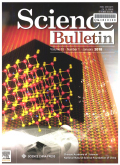- 钛学术文献服务平台 \
- 学术期刊 \
- 基础科学期刊 \
- 自然科学总论期刊 \
- 科学通报(英文版)期刊 \
Mn2+doping enabled efficient high-color-rendering single-phase white-emitting lead halide perovskites
Mn2+doping enabled efficient high-color-rendering single-phase white-emitting lead halide perovskites
基本信息来源于合作网站,原文需代理用户跳转至来源网站获取
摘要:
The development of high-color-rendering phosphor-converted white light-emitting diodes(w-LEDs)is highly demanded for high-quality solid-state white lighting[1-4].In modern society,white-light sources with excellent color rendering index(CRI)exceeding 90 are required in some color-critical applications,for examples,art gallery,photography,cinematography,museum,jewelry shops and surgery[5,6].Although the near-UV-pumped w-LEDs fabricated with near-UV LED chips and RGB(red/green/blue)tricolor phosphors can offer a high-color-rendering white-light emission,but the output color balance is difficult to control and the absorption problem among tricolor phosphors leads to reduction of photoluminescence quantum yields(PLQYs)[7].Therefore,to avoid these issues,it is crucial to find an efficient near-UV-excitable single-phased white-emitting phosphor,which exhibits broad emission in the entire visible spectrum range from 400 to 700 nm.In view of this situation,some research groups made great efforts to develop single-phased white-light phosphors for near-UV-pumped w-LEDs,and some promising white emitters were discovered in,such as,K2Ca(PO4)F︰Eu2+(Ra = 87.6,R9 = 65)[8],K2BaCa(PO4)2_x(BO3)x︰Eu2+(Ra = 90.4,R9 = 93.8)[9],and Ca2(BO3)1-x(PO4)xCl:Eu2+(Ra = 83.4,R9 = 39.3)[10].However,these white-light phosphors are commonly based on rare-earth Eu2+ions,which are very expensive.The shortages in supply or increases in price for rare-earth elements have already been a glo-bal problem,which might lead to disastrous effects in the solid-state lighting industry in the future.Moreover,the preparation of these Eu2+doped phosphors requires complicate synthesis proce-dures including high-temperature and reducing atmosphere,thus causing remarkable increase in product cost.Therefore,the search for alternative rare-earth-free high-efficiency single-component white-light-emitting materials is very important and urgent.

推荐文章
Lie color代数的全形
Lie color代数
全形
color导子代数
完备Lie color代数
Rapid and sensitive method for determining free amino acids in plant tissue by high-performance liqu
HPLC
OPA
FMOC
Free amino acids
Plant
PLS-DA
A re-assessment of nickel-doping method in iron isotope analysis on rock samples using multi-collect
Fe isotope
Ni-doping
Stable isotope
Precision and accuracy
Mass bias correction
Pseudo-high mass resolution
Thermodynamic properties of San Carlos olivine at high temperature and high pressure
San Carlos olivine
Thermodynamic property
Thermal expansion
Heat capacity
Temperature gradient
内容分析
关键词云
关键词热度
相关文献总数
(/次)
(/年)
引文网络
引文网络
二级参考文献 (0)
共引文献 (0)
参考文献 (12)
节点文献
引证文献 (0)
同被引文献 (0)
二级引证文献 (0)
2014(2)
- 参考文献(2)
- 二级参考文献(0)
2015(1)
- 参考文献(1)
- 二级参考文献(0)
2016(1)
- 参考文献(1)
- 二级参考文献(0)
2017(3)
- 参考文献(3)
- 二级参考文献(0)
2018(1)
- 参考文献(1)
- 二级参考文献(0)
2019(4)
- 参考文献(4)
- 二级参考文献(0)
2021(0)
- 参考文献(0)
- 二级参考文献(0)
- 引证文献(0)
- 二级引证文献(0)
引文网络交叉学科
相关学者/机构
期刊影响力
科学通报(英文版)
主办单位:
中国科学院
出版周期:
半月刊
ISSN:
1001-6538
CN:
11-1785/N
开本:
大16开
出版地:
北京东黄城根北街16号
邮发代号:
2-177
创刊时间:
1950
语种:
eng
出版文献量(篇)
9507
总下载数(次)
1
总被引数(次)
58070
期刊文献
相关文献
推荐文献
- 期刊分类
- 期刊(年)
- 期刊(期)
- 期刊推荐
力学
化学
地球物理学
地质学
基础科学综合
大学学报
天文学
天文学、地球科学
数学
气象学
海洋学
物理学
生物学
生物科学
自然地理学和测绘学
自然科学总论
自然科学理论与方法
资源科学
非线性科学与系统科学
科学通报(英文版)2022
科学通报(英文版)2021
科学通报(英文版)2020
科学通报(英文版)2019
科学通报(英文版)2018
科学通报(英文版)2017
科学通报(英文版)2016
科学通报(英文版)2015
科学通报(英文版)2013
科学通报(英文版)2012
科学通报(英文版)2011
科学通报(英文版)2010
科学通报(英文版)2009
科学通报(英文版)2008
科学通报(英文版)2007
科学通报(英文版)2006
科学通报(英文版)2005
科学通报(英文版)2004
科学通报(英文版)2003
科学通报(英文版)2002
科学通报(英文版)2001
科学通报(英文版)2000
科学通报(英文版)2021年第9期
科学通报(英文版)2021年第8期
科学通报(英文版)2021年第7期
科学通报(英文版)2021年第6期
科学通报(英文版)2021年第5期
科学通报(英文版)2021年第4期
科学通报(英文版)2021年第3期
科学通报(英文版)2021年第24期
科学通报(英文版)2021年第2期
科学通报(英文版)2021年第18期
科学通报(英文版)2021年第17期
科学通报(英文版)2021年第16期
科学通报(英文版)2021年第15期
科学通报(英文版)2021年第14期
科学通报(英文版)2021年第13期
科学通报(英文版)2021年第12期
科学通报(英文版)2021年第11期
科学通报(英文版)2021年第10期
科学通报(英文版)2021年第1期

 免费查重
免费查重










